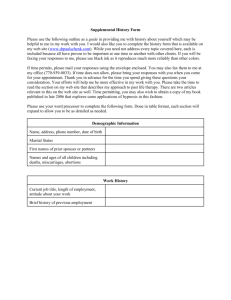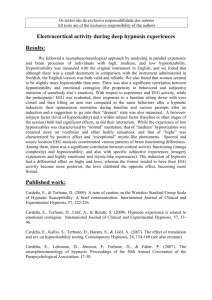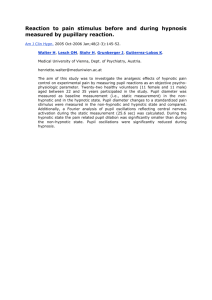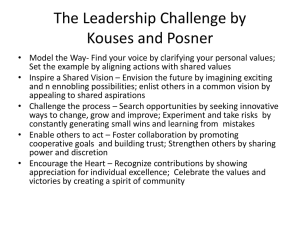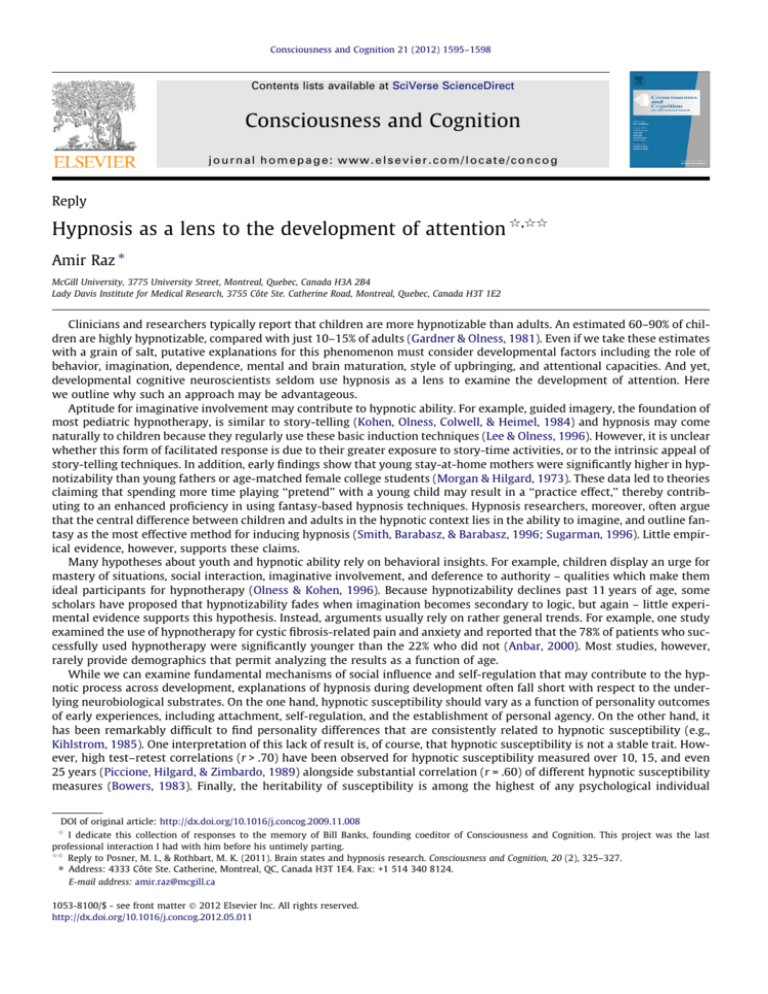
Consciousness and Cognition 21 (2012) 1595–1598
Contents lists available at SciVerse ScienceDirect
Consciousness and Cognition
journal homepage: www.elsevier.com/locate/concog
Reply
Hypnosis as a lens to the development of attention q,qq
Amir Raz ⇑
McGill University, 3775 University Street, Montreal, Quebec, Canada H3A 2B4
Lady Davis Institute for Medical Research, 3755 Côte Ste. Catherine Road, Montreal, Quebec, Canada H3T 1E2
Clinicians and researchers typically report that children are more hypnotizable than adults. An estimated 60–90% of children are highly hypnotizable, compared with just 10–15% of adults (Gardner & Olness, 1981). Even if we take these estimates
with a grain of salt, putative explanations for this phenomenon must consider developmental factors including the role of
behavior, imagination, dependence, mental and brain maturation, style of upbringing, and attentional capacities. And yet,
developmental cognitive neuroscientists seldom use hypnosis as a lens to examine the development of attention. Here
we outline why such an approach may be advantageous.
Aptitude for imaginative involvement may contribute to hypnotic ability. For example, guided imagery, the foundation of
most pediatric hypnotherapy, is similar to story-telling (Kohen, Olness, Colwell, & Heimel, 1984) and hypnosis may come
naturally to children because they regularly use these basic induction techniques (Lee & Olness, 1996). However, it is unclear
whether this form of facilitated response is due to their greater exposure to story-time activities, or to the intrinsic appeal of
story-telling techniques. In addition, early findings show that young stay-at-home mothers were significantly higher in hypnotizability than young fathers or age-matched female college students (Morgan & Hilgard, 1973). These data led to theories
claiming that spending more time playing ‘‘pretend’’ with a young child may result in a ‘‘practice effect,’’ thereby contributing to an enhanced proficiency in using fantasy-based hypnosis techniques. Hypnosis researchers, moreover, often argue
that the central difference between children and adults in the hypnotic context lies in the ability to imagine, and outline fantasy as the most effective method for inducing hypnosis (Smith, Barabasz, & Barabasz, 1996; Sugarman, 1996). Little empirical evidence, however, supports these claims.
Many hypotheses about youth and hypnotic ability rely on behavioral insights. For example, children display an urge for
mastery of situations, social interaction, imaginative involvement, and deference to authority – qualities which make them
ideal participants for hypnotherapy (Olness & Kohen, 1996). Because hypnotizability declines past 11 years of age, some
scholars have proposed that hypnotizability fades when imagination becomes secondary to logic, but again – little experimental evidence supports this hypothesis. Instead, arguments usually rely on rather general trends. For example, one study
examined the use of hypnotherapy for cystic fibrosis-related pain and anxiety and reported that the 78% of patients who successfully used hypnotherapy were significantly younger than the 22% who did not (Anbar, 2000). Most studies, however,
rarely provide demographics that permit analyzing the results as a function of age.
While we can examine fundamental mechanisms of social influence and self-regulation that may contribute to the hypnotic process across development, explanations of hypnosis during development often fall short with respect to the underlying neurobiological substrates. On the one hand, hypnotic susceptibility should vary as a function of personality outcomes
of early experiences, including attachment, self-regulation, and the establishment of personal agency. On the other hand, it
has been remarkably difficult to find personality differences that are consistently related to hypnotic susceptibility (e.g.,
Kihlstrom, 1985). One interpretation of this lack of result is, of course, that hypnotic susceptibility is not a stable trait. However, high test–retest correlations (r > .70) have been observed for hypnotic susceptibility measured over 10, 15, and even
25 years (Piccione, Hilgard, & Zimbardo, 1989) alongside substantial correlation (r = .60) of different hypnotic susceptibility
measures (Bowers, 1983). Finally, the heritability of susceptibility is among the highest of any psychological individual
DOI of original article: http://dx.doi.org/10.1016/j.concog.2009.11.008
q
I dedicate this collection of responses to the memory of Bill Banks, founding coeditor of Consciousness and Cognition. This project was the last
professional interaction I had with him before his untimely parting.
qq
Reply to Posner, M. I., & Rothbart, M. K. (2011). Brain states and hypnosis research. Consciousness and Cognition, 20 (2), 325–327.
⇑ Address: 4333 Côte Ste. Catherine, Montreal, QC, Canada H3T 1E4. Fax: +1 514 340 8124.
E-mail address: amir.raz@mcgill.ca
1053-8100/$ - see front matter Ó 2012 Elsevier Inc. All rights reserved.
http://dx.doi.org/10.1016/j.concog.2012.05.011
1596
A. Raz / Consciousness and Cognition 21 (2012) 1595–1598
difference measures (Morgan, 1973; Morgan, Hilgard, & Davert, 1970; Raz, 2008, 2010; Raz, Fan, & Posner, 2006). We can
speculate, as some scholars do, that hypnotic susceptibility is a dynamic pattern so unique that it follows its own developmental trajectory, independent of traditional psychological measures of individual differences. Whether or not we accept
such an assumption, however, to have such a stable tendency that is uncorrelated with other traditional individual-difference measures poses an intriguing scientific mystery.
Whereas little primary research addresses the role of age in hypnotizability, literature from developmental cognitive neuroscience traces the development of attention in reasonable detail (e.g., Posner & Rothbart, 2006, 2011). In adults most cognitive and emotional self-regulation involves a network of brain regions drawing on structures such as the anterior cingulate
cortex (ACC), insula, and areas of the basal ganglia, related to executive attention. During infancy and throughout early
development, however, control systems depend primarily upon a brain network involved in orienting to sensory events that
includes areas of the parietal lobe and frontal eye fields. Studies of human adults and alert non-human primates reveal that
the brain network involved in orienting to sensory events largely depends on the neurochemical input of the nicotinic cholinergic system arising in the nucleus basalis. Cholinergic systems arising in the basal forebrain play a critical role in orienting. Lesions of the basal forebrain in monkeys interfere with orienting attention; however, the superior parietal lobe, rather
than basal forebrain, appears to educe these effects. Injections of scopolamine directly into the lateral interparietal area of
monkeys – a brain area containing cells, which are influenced by cues about spatial location – have been shown to have a
large effect on the ability to shift attention to a target while systemic injections of scopolamine have a smaller effect on covert orienting than do local injections in the parietal area (Voytko et al., 1994).
Empirical findings support the notion that three brain networks control attention (Raz & Buhle, 2006). The alerting network obtains and maintains the alert state; the orienting network is involved in the selection of sensory events; and the
executive network resolves conflict among response tendencies (Posner & Fan, 2008; Posner & Petersen, 1990). These networks are distinct at least in the sense that they serve different functions, have different neural anatomies, and involve different neuromodulators (Posner & Fan, 2008; Rueda, Posner, & Rothbart, 2011). A major advantage of viewing attention as an
organ system is to trace the ability of children and adults to regulate their thoughts and feelings. Over the first few years of
life the regulation of emotion is a major issue of development.
Recent imaging studies have examined the brain activity of infants and young children at rest using functional magnetic
resonance imaging (fMRI). These studies provide data from newborns and infants up to a year old (Gao et al., 2009) as well as
from children of 9 years of age, adolescents, and teenagers (Fair, Dosenbach, Petersen, & Schlaggar, 2011; Fair et al., 2009;
Fransson et al., 2007). These studies have collectively examined two attention networks related to control systems (Fair
et al., 2011): the fronto-parietal network and the cingulo-opercular network. During early development the two networks
cooperate closely together, while in adulthood the cingulo-opercular network becomes independent from the fronto-parietal
network. Drawing on the neural substrates of the orienting network, the fronto-parietal network is important for rapidly
adaptive control and shorter timescales whereas the cingulo-opercular network draws on the neural infrastructure of the
executive network and maintains stable set-maintenance while operating at longer timescales.
These connectivity results propose that the control structures involved in executive attention – including structures on
the medial aspect of the frontal lobe (e.g., ACC) and parietal lobe (e.g., operculum) – are active during early development
but mature to wield fuller control only later in life. The parallels in brain networks emanating from studies of adult attention
(e.g., Posner & Fan, 2008) and from developmental studies of resting fMRI connectivity (e.g., Fair et al., 2009, 2011) may unravel the story of the development of attention in infants and young children and shed light on pediatric hypnosis.
Altering attention can occur in a number of ways. Michael Posner and his colleagues, for example, have tried to distinguish attention training from attention state training and have been able to demonstrate alterations in white matter connectivity in critical areas related to the ACC (Tang et al., 2010). This form of training can improve attentional performance and
response to stress and has been used with individuals as young as 4 years of age. Researchers such as Posner, moreover, have
pursued the study of the changes in control in early life from orienting to executive attention showing increased fronto-parietal (i.e., orienting) network activity at rest with reduced cingulo-cuneus activity (i.e., executive) (Posner, Rothbart, Sheese, &
Voelker, 2011).
As a form of attentive-receptive concentration, hypnosis may have an evolutionary function or survival value. While it’s
certainly possible that the hypnotic experience has no value today and that it remains an epiphenomenon that may have
served a historical purpose no longer required, the functional value of hypnosis is apparent in aspects such as pain regulation
(Holroyd, 1996), modulation of the immune system (Kiecolt-Glaser, Marucha, Atkinson, & Glaser, 2001), and the ability to
enhance treatment effectiveness (Kirsch, Montgomery, & Sapirstein, 1995), to name but a few.
Hypnosis is an advantageous tool to interface with the notion that during infancy orienting serves as the primary control
system while later in childhood effortful control becomes dominant. Control during infancy would be mainly in relation to
emotion and only later related to cognition. Parents and caregivers probably propel the development of self- regulation and
exercise executive systems through the presentation of novel stimuli (e.g., new objects or people). Reading to the child may
be another form of this type of stimulation. Some cultures thrive on observation making ‘‘active watching’’ the main learning
venue of the developing young. Such cultures may prepare the executive attention network of infants through orienting to
novel stimuli. The cingulate system appears to function, at least for the detection of errors, as early as 7-months of age
(Berger, Tzur, & Posner, 2006) and with epigenetic and environmental interactions shaping the development of the networks
in later life (Sheese, Voelker, Rothbart, & Posner, 2007; Voelker, Sheese, Rothbart, & Posner, 2009), training can increase the
A. Raz / Consciousness and Cognition 21 (2012) 1595–1598
1597
efficiency of white matter connections even in adults (Tang et al., 2010). Assuming that novelty in infants and adults share
similar mechanisms, therefore, cingulate activity may forge the connections found in later life.
No biological marker currently exists for indexing either hypnotizability or the hypnotic experience. In other words, neither a brain scan nor a blood test can determine if a person is either highly hypnotizable (HH) or currently experiencing hypnosis. Whereas most children tend to be HH with a peak around 11–12 years of age, hypnotizability seems to gradually settle
thereafter, and adult hypnotizability seems to be a stable feature – some scholars even liken it to a fingerprint. A small number of studies, however, report that individuals may increase hypnotic responsiveness through training (Gorassini & Spanos,
1998). Although controversial, hypnotizability training (HT) aims to teach individuals how to direct their attention in a specific fashion to achieve a hypnotic experience. While critics argue that the observed responses may arise due to a combination of factors, including training-to-task and a certain measure of theatrics and self-deception, little research has examined
HT in depth. It would be interesting to see, for example, whether low hypnotizables (LH) who undergo HT can parallel the
performance of untrained HH (e.g., to examine if LH-turned-HH via HT can override automatic effects such as those measured by Stroop and McGurk tasks). Similar to HT, attention training (AT) is a form of cognitive intervention aimed at exercising specific control networks (Rabipour & Raz, 2012). Behavioral programs, including AT, have become ubiquitous and
allege to be valuable adjuncts, if not rivals, to conventional pharmacotherapy, especially in children (e.g., in Tourette’s syndrome) (Piacentini et al., 2010). These non-drug options appeal to patients who must often choose between side-effect-laden
medication and other less conventional alternatives. The marriage of pediatric hypnosis with attention seems a promising
way to further unravel a meaningful crosstalk relevant to the development of control networks.
References
Anbar, R. D. (2000). Self-hypnosis for patients with cystic fibrosis. Pediatric Pulmonology, 30, 461–465.
Berger, A., Tzur, G., & Posner, M. I. (2006). Infant brains detect arithmetic errors. Proceedings of the National Academy of Science of the United States of America,
103, 12649–12653. http://dx.doi.org/10.1073/pnas.0605350103.
Bowers, K. S. (1983). Hypnosis for the seriously curious. New York, NY: Norton.
Fair, D. A., Cohen, A. L., Power, J. D., Dosenbach, N. U. F., Church, J. A., Miezin, F. M., et al (2009). Functional brain networks develop from a ‘‘local to
distributed’’ organization. PLoS Computational Biology, 5, e1000381. http://dx.doi.org/10.1371/journal.pcbi.1000381.
Fair, D. A., Dosenbach, N. U. F., Petersen, S. E., & Schlaggar, B. L. (2011). Resting state studies on the development of control systems. In M. I. Posner (Ed.),
Cognitive neuroscience of attention (2nd ed., pp. 291–311). New York, NY: Guilford.
Fransson, P., Skiold, B., Horsch, S., Nordell, A., Blennow, M., Lagercrantz, H., et al (2007). Resting-state networks in the infant brain. Proceedings of the National
Academy of Sciences USA, 104, 15531–15536. http://dx.doi.org/10.1073/pnas.0704380104.
Gao, W., Zhu, H., Giovanello, K. S., Smith, J. K., Shen, D., Gilmore, J. H., et al (2009). Evidence on the emergence of the brain’s default network from 2-week-old
to 2-year-old healthy pediatric subjects. Proceedings of the National Academy of Sciences USA, 106, 6790–6795. http://dx.doi.org/10.1073/
pnas.0811221106.
Gardner, G. G., & Olness, K. (1981). Hypnosis and hypnotherapy with children. New York, NY: Grune & Stratton.
Gorassini, D. R., & Spanos, N. P. (1998). The Carleton Skill Training Program for Modifying Hypnotic Suggestibility: Original Version and Variations. In I.
Kirsch, A. Capafons, E. Cardeña-Buelna, & S. Amigó (Eds.), Clinical Hypnosis and Self-Regulation Therapy: Cognitive-Behavioral Perspective (pp. 141–177).
Washington, DC: American Psychological Association.
Holroyd, J. (1996). Hypnosis treatment of clinical pain: Understanding why hypnosis is useful. International Journal of Clinical and Experimental Hypnosis, 44,
33–51.
Kiecolt-Glaser, J., Marucha, P., Atkinson, C., & Glaser, R. (2001). Hypnosis as a modulator of cellular immune dysregulation during acute stress. Journal of
Consulting and Clinical Psychology, 69, 674–682.
Kihlstrom, J. F. (1985). Hypnosis. Annual Review of Psychology, 36, 385–418.
Kirsch, I., Montgomery, G., & Sapirstein, G. (1995). Hypnosis as an adjunct to cognitive-behavioral psychotherapy: A meta-analysis. Journal of Consulting and
Clinical Psychology, 63, 214–220.
Kohen, D. P., Olness, K. N., Colwell, S. O., & Heimel, A. (1984). The use of relaxation-mental imagery (self-hypnosis) in the management of 505 pediatric
behavioral encounters. Journal of Developmental and Behavioral Practice, 5(1), 21–25.
Lee, L. H., & Olness, K. N. (1996). Effects of self-induced mental imagery on autonomic reactivity in children. Developmental and Behavioral Pediatrics, 17(5),
323–327.
Morgan, A. (1973). The heritability of hypnotic susceptibility in twins. Journal of Abnormal Psychology, 82, 55–61.
Morgan, A. H., & Hilgard, E. R. (1973). Age differences in susceptibility to hypnosis. International Journal of Clinical and Experimental Hypnosis, 21(2), 78–85.
http://dx.doi.org/10.1080/00207147308409308.
Morgan, A. H., Hilgard, E. R., & Davert, E. C. (1970). The heritability of hypnotic susceptibility of twins: A preliminary report. Behavior Genetics, 1(3–4),
213–224. http://dx.doi.org/10.1007/BF01074653.
Olness, K., & Kohen, D. P. (1996). Hypnosis and hypnotherapy with children (3rd ed.). New York, NY: Guilford Press.
Piacentini, J., Woods, D. W., Scahill, L., Wilhelm, S., Peterson, A. L., Chang, S., et al (2010). Behavior Therapy for Children With Tourette Disorder A
Randomized Controlled Trial. Jama-Journal of the American Medical Association, 303(19), 1929–1937.
Piccione, C., Hilgard, E. R., & Zimbardo, P. G. (1989). On the degree of stability of measured hypnotizability over a 25-year period. Journal of Personality and
Social Psychology, 56(2), 289–295.
Posner, M. I., & Fan, J. (2008). Attention as an organ system. In J. R. Pomerantz (Ed.), Topics in Integrative Neuroscience (pp. 31–61). New York NY: Cambridge
University Press. http://dx.doi.org/10.1017/CBO9780511541681.005.
Posner, M. I., & Petersen, S. E. (1990). The attention system of the human brain. Annual Review of Neuroscience, 13, 25–42. http://dx.doi.org/10.1146/
annurev.ne.13.030190.000325.
Posner, M. I., & Rothbart, M. K. (2006). Educating the Human Brain. Washington, DC: American Psychological Association.
Posner, M. I., & Rothbart, M. K. (2011). Brain states and hypnosis research. Consciousness and Cognition, 20(2), 325–327.
Posner, M. I., Rothbart, M. K., Sheese, B. E., & Voelker, P. (2011). Control networks and neuromodulators of early development. Developmental Psychology.
http://dx.doi.org/10.1037/a0025530.
Rabipour, S., & Raz, A. (2012). Training the brain: Fact and fad in cognitive and behavioral remediation. Brain and Cognition, (In Press).
Raz, A. (2008). The genetics of attention and hypnotizability elucidate placebo. International Journal of Clinical and Experimental Hypnosis, 56(1), 99–116.
Raz, A. (2010). From the genetic basis of heritable traits toward ontological cognitive neuroscience. Neuropsychoanalysis, 12(1), 47–48.
Raz, A., & Buhle, J. (2006). Typologies of attentional networks. Nature Reviews Neuroscience, 7(5), 367–379.
Raz, A., Fan, J., & Posner, M. I. (2006). Neuroimaging and genetic associations of attentional and hypnotic processes. Journal of Physiology, 99(4–6), 483–491.
1598
A. Raz / Consciousness and Cognition 21 (2012) 1595–1598
Rueda, M. R., Posner, M. I., & Rothbart, M. K. (2011). Attentional control and self-regulation. In R. F. Baumeister & K. D. Vohs (Eds.), Handbook of selfregulation: Research, theory, and applications (2nd ed., pp. 283–300). New York, NY: Guilford Press.
Sheese, B. E., Voelker, P. M., Rothbart, M. K., & Posner, M. I. (2007). Parenting quality interacts with genetic variation in dopamine receptor DRD4 to influence
temperament in early childhood. Development and Psychopathology, 19, 1039–1046. http://dx.doi.org/10.1017/S0954579407000521.
Smith, J. T., Barabasz, A., & Barabasz, M. (1996). Comparison of hypnosis and distraction in severely ill children undergoing painful medical procedures.
Journal of Counseling Psychology, 43(2), 187–195.
Sugarman, L. I. (1996). Hypnosis in a primary care practice. Developing skills for the ‘‘new morbidities’’. Developmental and Behavioral Pediatrics, 17(5),
300–306.
Tang, Y., Lu, Q., Geng, X., Stein, E. A., Yang, Y., & Posner, M. I. (2010). Short term mental training induces white-matter changes in the anterior cingulate.
Proceedings of the National Academy of Sciences of the USA, 107, 16649–16652. http://dx.doi.org/10.1073/pnas.1011043107.
Voelker, P., Sheese, B. E., Rothbart, M. K., & Posner, M. I. (2009). Variations in catechol-o-methyltransferase gene interact with parenting to influence
attention in early development. Neuroscience, 164, 121–130. http://dx.doi.org/10.1016/j.neuroscience.2009.05.059.
Voytko, M. L., Olton, D. S., Richardson, R. T., Gorman, L. K., Tobin, J. R., & Price, D. L. (1994). Basal forebrain lesions in monkeys disrupt attention but not
learning and memory. Journal of Neuroscience, 14(1), 167–186.



